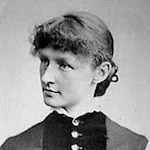
Annie Jump Cannon
Introduction
Annie Jump Cannon was a groundbreaking female astronomer, responsible for the classification of over 400,000 stellar objects. Her system--known as the Harvard System of Spectral Classification--examined the spectral lines emitted by distant stars to categorize their size and development within the stellar life cycle. Cannon’s pioneering work and classification system is still in use today.
Her Life and Legacy
Born in Dover, Delaware in the midst of civil war, Annie Jump Cannon first began her astronomical discoveries as a young girl, observing and charting the night skies through a gap in her attic window. By the time of her death in 1941, she was deemed “the most famous woman astronomer in the world,”carrying on a profound legacy as both a celebrated trailblazer and thinker.
After receiving her Bachelor of Science degree from Wellesley College in 1884, she then began her work at Radcliffe College under the guidance of prominent astronomer Edwin Pickering as a ‘computer.’ There, Cannon and the other female ‘computers’ spent their time tediously making calculations and examining photographs to help catalogue and categorize stars by their stellar temperatures.
Moving to more independent work, Cannon was officially named Curator of Astronomical Photographs at Harvard in 1911. Ever dedicated to her craft, Cannon even travelled all the way to Harvard’s observatory in Arequipa, Peru during this period to photograph the Southern sky herself. From there, Cannon cultivated a name for herself by identifying and classifying stars. By 1922, the International Astronomical Union adopted Cannon’s new classification system--dubbed the Harvard System of Spectral Classification. Her system simplified it’s many predecessors, by categorizing stars as either O, B, A, F, G, K, or M stars based on the spectral lines emitted by each stellar body. With Cannon’s spectral readings, she determined that certain colors and patterns corresponded with different stellar temperatures, with O type stars being the hottest and M type stars being the coolest. These spectral types were then incorporated into the famous Hertzsprung-Russell Diagram, which charts stars based on their spectral class and their luminosity. With this combined information, the Hertzsprung-Russell diagram helps establish a star’s current stage in the stellar life cycle. In short, Annie Jump Cannon’s work had a profound impact on the astronomical community, and her contributions are still relied upon today.
By the time of her death in 1941, Cannon recorded nearly 400,000 stellar objects. For her assiduous work, Cannon received numerous accolades. The National League of Women Voters named her to their list of the 12 “Greatest Living American Women” in 1929. Cannon received the coveted Henry Draper Medal from the National Academy of Sciences in 1931. In 1938, she was officially named to the Harvard faculty as the William Cranch Bond Astronomer. She received six honorary degrees, wherein she was the first female recipient of an honorary degree from Oxford University. She was the first woman ever to be elected as an officer of the American Astronomical Society.
When asked to reflect on her life’s work, Cannon left us with the following: “My success, if you would call it that, lies in the fact that I have kept at my work all these years. It is not genius, or anything like that, it is merely a patience.”
Annie Jump Cannon died in Cambridge, Massachusetts on April 13th, 1941, at the age of 77.
Why Was She Here?
Annie Jump Cannon signed the VVO Guestbook on August 30th, 1921. She was only a few months away from the adaptation of her stellar classification system by the International Astronomical Union. At this point, Cannon had been working as a Curator of Astronomical Photographs for ten years, and her initial groundbreaking ideas must have been complete. Given these factors, why did she visit the Observatory at this time?
As it turns out, she and many other prominent astronomers came that day as Wesleyan hosted a meeting of the American Astronomical Society (AAS) at the observatory. Though not the fully-fledged officer that she would one day become, Cannon no doubt had great interest in the happenings and discussions of the AAS. On this day, she was one of 20 women present to hear discussions regarding the upcoming solar eclipse, variable stars, and work with the American Meteor Society. We can only speculate whether the inspiration found at the meeting or on the Wesleyan campus perhaps added an extra spark to reinvigorate her on what would continue to be exhilarating professional journey.
Resources
American Astronomical Society. “26th Meeting of the American Astronomical Society (AAS).” The American Astronomical Society. August, 1921. https://had.aas.org/resources/aashistory/early-meetings/1916-1922#26.
Australia Telescope National Facility. “Classifying Stars - The Hertzsprung-Russell Diagram.” The Commonwealth Scientific and Industrial Research Organization. http://astro.unl.edu/naap/hr/hr_background1.html.
Bok, P.F.. “Annie Jump Cannon, 1863-1941.” Publications of the Astronomical Society of the Pacific. 53, no. 313. (June 1941): 169. http://articles.adsabs.harvard.edu//full/1941PASP...53..168B/0000169.000.html.
Cannon, Annie J. et. al. “The Henry Draper Catalogue.” Annals of the Astronomical Observatory at Harvard College. 92. (1918). https://archive.org/stream/henrydrapercata00obsegoog#page/n16/mode/2up.
Geiling, Natasha. “The Women Who Mapped the Universe and Still Couldn’t Get Any Respect.” The Smithsonian Institution. September 18, 2013. https://www.smithsonianmag.com/history/the-women-who-mapped-the-universe-and-still-couldnt-get-any-respect-9287444/?no-ist.
Obituary of Annie J. Cannon. The New York Times. April 14, 1941. https://timesmachine.nytimes.com/timesmachine/1941/04/14/85480013.html?pageNumber=17.
University of Nebraska-Lincoln. “Spectral Classification of Stars.” Astronomy Department of the University of Nebraska-Lincoln. http://astro.unl.edu/naap/hr/hr_background1.html.
The Facts
OccupationAstronomer
Date & Place of BirthDecember 11, 1863 in Dover, Delaware, USA
Date & Place of DeathApril 13th, 1941 in Cambridge, Massachusetts, USA
Alma MaterWellesley College
Harvard College
Observatory AffiliationHarvard College Observatory
Date of Wesleyan VisitAugust 30, 1921 (age 57 at time of visit)